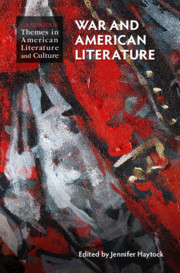Book contents
- War and American Literature
- Cambridge Themes in American Literature and Culture
- War and American Literature
- Copyright page
- Contents
- Contributors
- Acknowledgments
- Chronology
- Introduction
- Part I Aspects of War in American Literature
- Part II Cultural Moments and the American Literary Imagination
- Part III New Lines of Inquiry
- Further Reading
- Index
Introduction
Published online by Cambridge University Press: 20 January 2021
- War and American Literature
- Cambridge Themes in American Literature and Culture
- War and American Literature
- Copyright page
- Contents
- Contributors
- Acknowledgments
- Chronology
- Introduction
- Part I Aspects of War in American Literature
- Part II Cultural Moments and the American Literary Imagination
- Part III New Lines of Inquiry
- Further Reading
- Index
Summary
Unaware that people in the United States fought for freedom before the French brewed their Revolution, Gabriel uses the knowledge that violence can facilitate a better future to lead his fellows in an uprising intended to change the legal and social order of slave-holding Virginia. Near the end of the novel, however, an unnamed character, a veteran of Toussaint’s uprising in Haiti, watches the captured Gabriel pass through the streets and meditates on the costs of war: he knows that “words like freedom and liberty drip blood” (196, emphasis in original). In American ideology, freedom demands sacrifices, including dying, seeing comrades die, and living with the act of killing. As Bontemps suggests, the full consequences of violent conflict may be apparent only after the event. Further, while Bontemps’ novel reaches back to explore a forgotten historical moment, Black Thunder also spoke to its contemporary context: in the 1930s, as fascism flourished overseas, Bontemps was keenly aware of oppression against blacks across the diaspora – and of movements to unite and resist. Thus this representation of an aborted skirmish in a war that took another sixty-one years to be declared shows how imaginative renderings of one conflict may in fact have much to do with another.
- Type
- Chapter
- Information
- War and American Literature , pp. 1 - 10Publisher: Cambridge University PressPrint publication year: 2021



